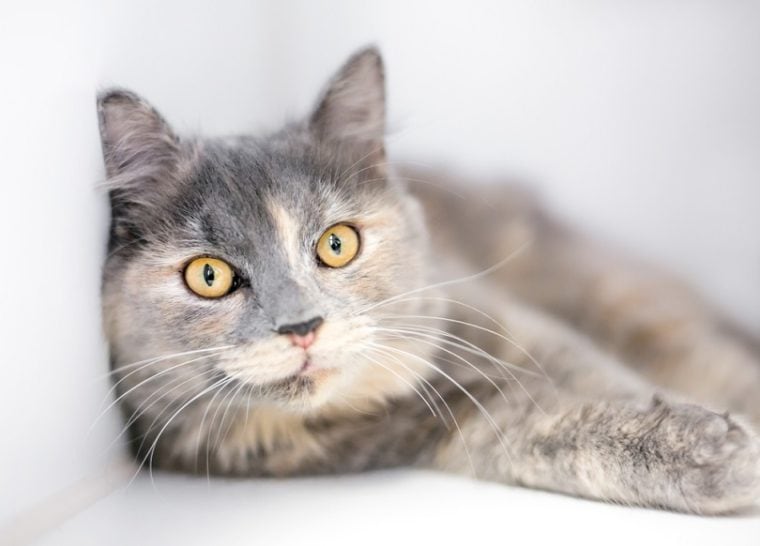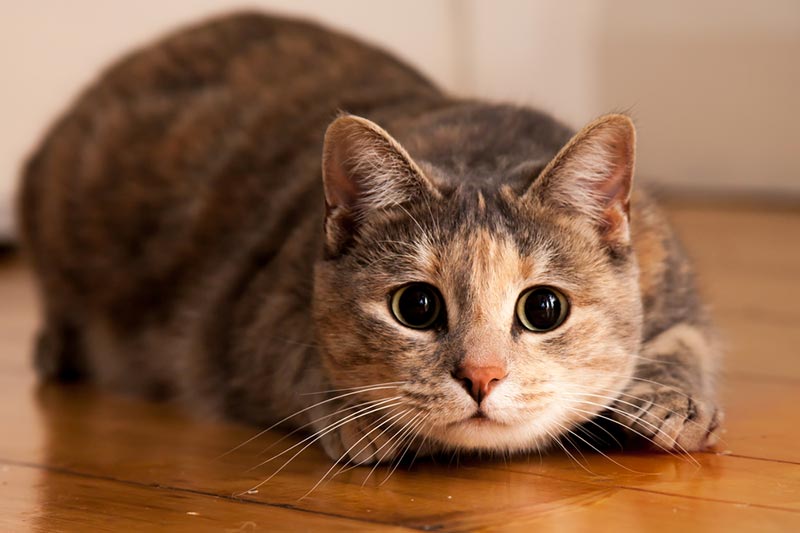
Click to Skip Ahead
The Lilac Tortoiseshell cat isn’t a breed but a specific color and pattern that can be seen on many breeds. The Tortoiseshell pattern is usually a mottled, flecked orange and black color with very little (if any) white. Lilac Tortoiseshells are a beautiful variant of this pattern, which is rarer than the other Tortoiseshell colors. The cats most likely to show this color pattern are American Shorthairs, British Shorthairs, Maine Coons, and Domestic Shorthairs. Read on to find out more about this beautiful cat!
The Lilac Tortoiseshell is only found in cats that carry the dilute gene, which causes the beautiful muted colors. Normal Tortoiseshells express black and orange color genes, but the Lilac version sees these colors diluted into a pale, silvery purple and cream. You can also see Tortoiseshell cats with chocolate and gold coats rather than the classic black and orange, but Torties must have the dilution gene to get the stunning Lilac colors.
Lilac Tortoiseshell Characteristics
A Lilac Tortoiseshell’s characteristics will depend on its breed!
The Earliest Records of Lilac Tortoiseshells in History
The history behind the mysterious Lilac Tortoiseshell is hard to pin down, as it is not one breed but many. However, the first mention of a Lilac Tortoiseshell in recorded history is of a Persian show winner named Topsy, who won a cat show in Hounslow in the UK in 1875.
However, Topsy isn’t the first time the Tortoiseshell is mentioned in history. There are myths and legends surrounding these cats that date back to the ancient Khmer people of Cambodia, who still include the Tortie in their rituals and ceremonies to this day.
The Khmer have kept Tortoiseshell cats for a very long time; the people first made their mark in history in 2000 BC and even today use “female, three-color cats” (Tortoiseshells) in the Royal Palace during ceremonies. These Torties are said to bless the nation with prosperity!
The Ancient Celts (1000BC) also felt the magic of the Lilac Tortoiseshell; they saw the Tortoiseshell cat as a bringer of good luck. The magic of Tortoiseshell cats spread worldwide and still perseveres today, with some in the US calling them “money cats” and Japanese fishermen inviting male Torties onto their ships for luck.

How Lilac Tortoiseshells Gained Popularity
The Lilac Tortoiseshell is preceded by the myths surrounding it, which makes it an intriguing cat, to begin with. Tortoiseshells have always had a place with people, and the purple smoke of the Lilac Tortoiseshell is rare enough to make it highly desirable. This rarity makes these cats popular, particularly when they began to be shown (such as Topsy back in 1875).
Male Lilac Tortoiseshells are even rarer, so they are highly coveted cats. The fact that this coloring and pattern is available in many breeds makes it even more popular among cat lovers and show cat owners alike!
Lilac Tortoiseshell Personality
Lilac Tortoiseshell cat owners will tell you their cats are more “spirited” than others, and some will even call them aggressive! Famous cat behavior expert Jackson Galaxy believes Tortoiseshell cats are “more sensitive to environmental stimuli,” meaning their distinct personalities might make them more prone to reactivity.
Two studies asked owners about their Tortoiseshell cat’s behavior, and one found that owners were more likely to say their Tortie was naughty. Some owners stated that their cats “always wanted things done in their way” and that they had more attitude (referred to by the owners as “tortitude”). The other found a connection between the Tortoiseshell coat color and aggressive behavior towards owners!
However, another study found no connection between Tortoiseshell coat colors and decreased trainability. Each Lilac Tortie will be an individual; its personality will depend on its socialization as a kitten, life experiences, and breed.
Top 6 Unique Facts About Lilac Tortoiseshells
1. Most Lilac Tortoiseshell Cats Are Female
Of all the cats that are Tortoiseshell of any color, 99.9% are female! This is because of the genes needed to create the signature two-tone mottled effect of the coat pattern. These colors are found on X chromosomes, and females have two (XX). Because male cats only have one X (XY), they can only express one of the colors in their coat (in Lilac Tortoiseshells, either Lilac or yellow-cream).
2. Lilac Tortoiseshell Cats Can Be Male
Despite nearly all Tortoiseshells being female, the cats can be male under certain circumstances. For example, a male cat with a genetic abnormality that gives them two X chromosomes (XXY) can have both coat colors needed for the Tortoiseshell pattern! However, this is very rare, and it often results in the male cat being sterile due to imbalanced sex chromosomes.

3. Tortoiseshell Coats in Male Cats Can Be Caused By Different Things
Male Tortoiseshell cats can be created in two different ways due to cell changes when the cat is still in its mother’s womb. Chimerism is the first, in which two fraternal twin kitten fetuses fuse in the mother cat’s womb. The remaining kitten inherits another X chromosome and can express both colors resulting in Tortoiseshell patterning. Mosaic is the second, in which one Tortie kitten fetus inherits extra cells, resulting in two X chromosomes.
4. Many Breeds Can Be Lilac Tortoiseshell
Many breeds express the Lilac Tortoiseshell coloring, and it’s more common in some breeds than others. American Shorthairs, British Shorthairs, Maine Coons, and Domestic Shorthaired cats are all commonly seen with Tortie colors, and some are even allowed in the breed standard!
5. Dilute Tortoiseshell Cats Are Rare
The beautiful coloring of Lilac Tortoiseshell cats is very rare and is a result of the genes responsible for the Tortoiseshell coloring being diluted. Because these dilute genes only have a chance to express in each kitten, the Lilac Tortoiseshell is a very rare color. Male Lilacs are even more so!
6. Male Lilac Tortoiseshells Often Have Health Problems
As beautiful and rare as these cats are, they can suffer for their beauty. When a male cat has more X chromosomes than normal, a condition similar to Klinefelter disease can occur. Cats can have cognitive difficulties, changes in their testicles and body shape, and can have weaker bones. Some cats show no physical signs at all, but there’s always the chance that kittens can be born with abnormalities due to the extra chromosome.
Does the Lilac Tortoiseshell Make a Good Pet?
While the “naughty Tortie” label can be hit-or-miss for these cats, the real answer to whether or not they’d be a good pet lies in the breed. Because all breeds have different characteristics, it’s essential to consider what you’d like your Lilac Tortoiseshell to be like before picking one.
For example, would you like a more laid-back Tortie or one that is always on the go? Do you want a cat that’s happy being alone for some of the day or one that craves attention? Because the Tortoiseshell pattern isn’t restricted to one particular breed, you have many choices when it comes to finding one that suits you and your family. Just be aware that some of them may be stubborn, and you’ll probably adopt a female!
Conclusion
Lilac Tortoiseshells are beautiful cats that are rare enough always to turn heads. Because they’re found in many breeds, you can get a cat that looks exactly how you want them to while being able to pick the breed, too. Some Tortoiseshells seemingly have distinct and “strong” personalities, but each cat is different. Most Lilac Tortoiseshell cats are female, but males are out there. If you adopt a male, be mindful of their health problems.
Featured Image Credit: Mary Swift, Shutterstock






